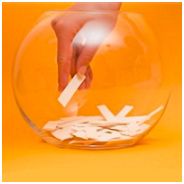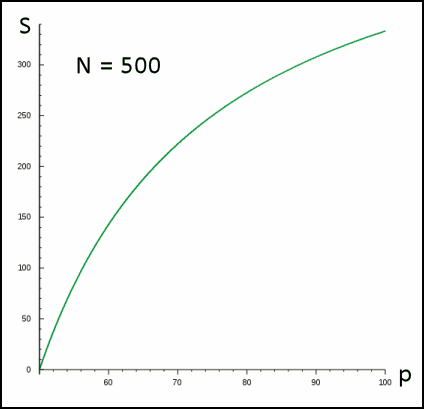The Drawn Democracy

Did you know that one of the main mechanisms that characterized for centuries democracy in Athens was based on drawing? For example, the 6,000 members of the Ήλιαία, that is the people’s court, were drawn, as were the 500 members of the βουλή, that is, the representative council of the city? Of course, the draw was among those citizens who, being qualified to be selected, volunteered. No one was forced to take a leading role against own will.
In addition, there were strict rules to prevent, working to draw, that were “elected” individuals who were not suitable for an institutional position or at least to ensure that the negative consequences of a non-optimal choice were kept to a minimum. For example, the magistratures were annual and could not be iterated, as people was not entitled to cumulate charges. In order to enable people from humble beginnings to access these charges, in addition, many roles were paid. There was also an entrance exam, a monthly statement and a statement on expiry of the term for each official.
This idea that democracy could be based on drawn representatives, rather than elected ones, it may seem strange to us, but it was for many centuries a fundamental principle, so that Aristotle himself said that the election was typical of the aristocracy and the draw was characteristic of democracy. The reason underlying this conception of democracy lies in the fact that with the draw all are equally likely to hold public office or to participate in a decision-making body, while the mechanism of elections is used to select a ruling class, to choose the alleged “best”. The first is therefore an egalitarian mechanism, whereas the second is an anti-egalitarian tool.
This concept, however, is not characteristic only of Athens and Ancient Greece. In the Renaissance, Florence, Orvieto, Siena, Pistoia, Lucca and Perugia, used the ballot, that is, the extraction of charges from a pool of previously elected nominations. This system was used for regular delivery of appointments, especially those of senior judges, in combination with a rotating system of charges for relatively short periods, ranging from 6 months to one year.
In Venice, some of the members of the Grand Council were drawn at random among all young people with more than twenty years, even if they did not belong to a rich or wealthy family. Following the example of the Venetian Republic, many northern cities, such as Parma, Ivrea, Brescia, and Bologna, adopted the draw in order to establish a neutral and impartial distribution of charges between the rich families and political factions vying for power. In practice it was a procedure aimed at resolving conflicts.
Also in Venice was used a very peculiar iterative system for the election of the Doge, made of alternating elections and draws. First were drawn 30 members of the Grand Council, which were subsequently reduced to 9 with a second draw. These were then to elect 40 people, each of whom had to get at least 7 out of 9 votes. At this point there was a third draw which reduced the 40 elected to 12, which in turn had to elect 25 other citizens, each of which must receive at least 9 of 12 votes. Fourth draw and 25 returned to be 9, which had to elect 45 citizens always at least 7 valid votes each. A fifth draw therefore reduced the 45 to 11 who had finally to elect the 41 Electors whose task was to elect the Doge. Every Elector should have received at least 9 out of 11 valid votes.
At this point each Elector had to choose a citizen and put his name in an urn from which a single name was extracted at random. These individual, however, to become Doge had to be “tried”, that is, he had to overcome a sort of examination in which he was called upon to defend himself from any accuse. At that point a final vote was then carried out by the Electors to decide whether the candidate has passed the exam. To become Doge he had to receive at least 25 votes in favor. If he did not succeed, another name was extracted from the urn, another action was instituted, and so on until the election of a Doge.
The choice of a charge by lot exists nowadays too. For example, in Italy six of the eight members of the Court of Assizes are chosen by lot among Italian citizens between 30 and 65 years. Similarly, the choice of examination committees or sport referees is performed by lot in many countries. Never, however, this technique has been used at national level in any country for institutional positions of some importance.
Recently, five professors from the University of Catania have developed a mathematical model that shows how the introduction of a certain percentage of independent deputies drawn at random would improve the efficiency of the parliamentary system. They are Maurizio Caserta and Salvatore Spagano, economists, Cesare Garofalo, sociologist, Alessandro Pluchino and Andrea Rapisarda, both physicists.
In practice, the five scholars have previously defined a metric for measuring the efficiency of a Parliament as a product of the percentage of laws passed by a legislature and social welfare that would result from these laws. The objective was to identify the optimal composition of the Parliament that would maximize the efficiency. To do this they used a simple but fairly realistic model, that is, one in which there are two coalitions, A and B, which are vying for power. Of course you can think of more complex models, but even this has provided interesting results.
They wanted to see how many MP’s, drawn at random and completely independent of the two coalitions in question, were necessary to include in the Parliament to achieve that result. Ultimately the used procedure was the following. First of all, elections were carried out to determine the relative percentages of seats to be allocated to each coalition. For example, 60% of the seats to the coalition A and 40% to the coalition B. Then, set the total number of seats to be filled, such as 500, it had to determine how many of these should be reserved for those two coalitions and how many for citizens drawn at random among all those interested in becoming members of Parliament. The rule stated that those who had been drawn in a legislature, could not be chosen again for the next one, or by lot or by election. For example, if you decided to appoint to the independent group 140 seats, there were still 360 to be divided between the two coalitions, that is, 216 to the A coalition and 144 to the B coalition.
The objective of the model was in fact to find a formula that would establish, for each percentage of the majority party, how many seats had to be reserved for the independent group. Making a number of simulations of legislative activities, in fact, it was found that both a Parliament with no independent MP’s, and one made only by MP’s chosen by lot, had essentially no efficiency. The reason is simple: in a party system, the party tends to impose a discipline so that if an MP proposes a law with the consent of the party, such a party will support that proposal, whether it is of benefit to the community or pursuing lobbying interests. So a Parliament made of only elected members will have a large number of approved laws but will provide very low value as regards social welfare. Obviously if MP’s were free to vote according to their conscience the result would be different, but we know that is rarely the case, at least in Italy. Conversely, a Parliament consisting of only independent members would generate laws that be more oriented to the collective advantage, but given that each proposal must gain the consent of a large number of independent members of parliament, the number of approved laws would be lower.
These results were in fact confirmed by a series of simulations that allowed to find a golden rule to determine the optimal number of independent members of Parliament against the percentage of votes obtained by the majority party. Said N the number of seats in Parliament and p the percentage of votes obtained by the majority party — by definition, the other party has obtained (100 – p) — the number S of MP’s who have to be selected by lot will be:
For example, in the case that Parliament is composed of 500 members, the resulting graph is the following:

In practice, with a majority of 60% at least 140 independent MP’s have to be drawn to have an efficient Parliament, but if the majority received as many as 81% of the vote, they should be more, that is, 275. In the first case we would have 216 seats for the coalition A, 144 for the coalition B, and 140 independent MP’s; in the second case we would have 182 seats for A, 43 for B with the remaining 275 for independents. Thus, the greater the strength of the majority party, the greater should be the number of independent aims to balance that dominance. Quite the opposite in practice of the majority bonus as provided in the porcellum (the current Italian voting system). It follows that this mechanism, based in part on the votes, partly on a draw, not only would not cause ungovernability but would make the Parliament more efficient.
All this may sound strange, but it’s true: the draw is a more democratic mechanism than election, and if done with certain criteria it would make more efficient our Parliament. Seeing is believing.




















Please use Facebook only for brief comments.
For longer comments you should use the text area at the bottom of the page.
Facebook Comments